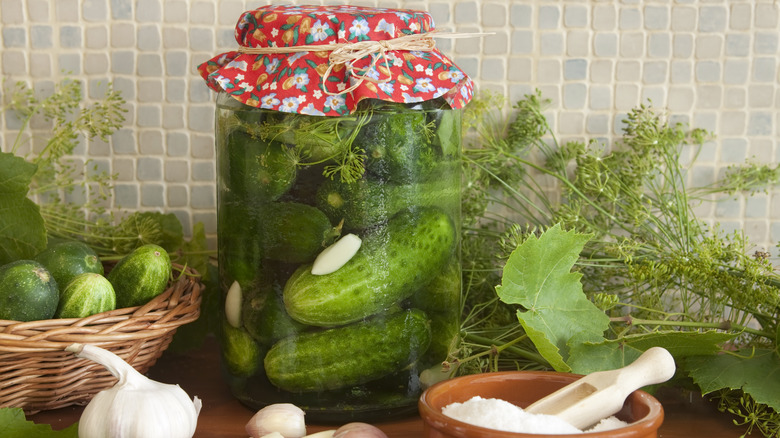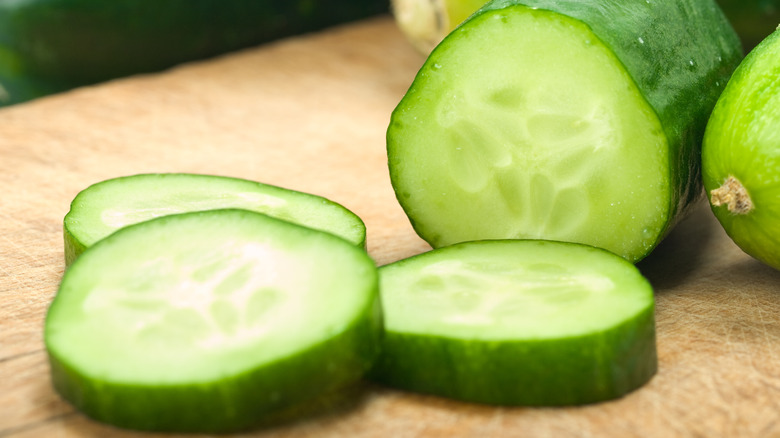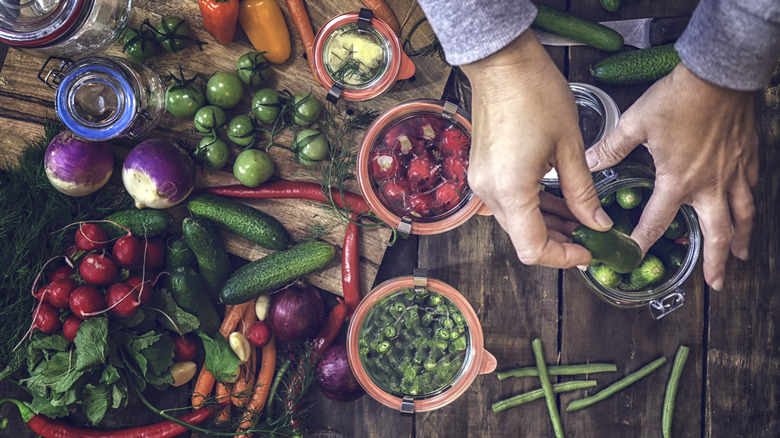Avoid Soggy Homemade Pickles By Adding Salt At The Right Time
Have you ever bought cucumbers at the grocery store only to find them becoming a soggy, waxy mess a few days later? That's the excess amount of water in the cucumber having nowhere to go, dampening and withering your crispy cuke away. That's manageable if you plan to eat your cucumbers quickly as is. But when eating pickles, the best bite is a crunchy and firm one. So, what's the number one way to ensure you transform your cucumbers into the best homemade pickles possible? Salt those cucumbers before you even think about putting them in the jar!
Whether you're slicing your cucumbers for quick pickle chips or pickling them whole, salting the cukes before canning in your brine is essential. Salt is already known to be an essential part of creating a pickling brine, but don't stop there. When you salt your cucumbers before canning, you draw out the excess moisture before jarring them, resulting in a crisp pickle. After all, cucumbers are made up of 96% water, so let the salt science get to work on your cucumbers to pickle them at their crispiest.
Cucumbers and canning salt 101
The key to the best pickles is not only in the timing but in the quality and variety of the ingredients you choose. Just as you need to be intentional with the kinds of cucumbers you choose for homemade pickles, you also want to have the right canning salt (also known as pickling salt) on hand. If you can't specifically find pickling salt on the shelves of your grocery store, make sure to go for a coarse salt. Kosher salt is a great example of a sufficient alternative.
Sprinkle your sliced cukes with the salt and let them sit — covered in ice — for a few hours before rinsing and canning. If you're not pressed for time and are using whole cucumbers, you can even create a saltwater bath for them, letting them soak for four to five hours or overnight in the refrigerator for the best crunch.
Make sure to go for cucumbers of the pickling variety when shopping. Smaller cucumbers are best and should not exceed 6 inches in length to be considered pickling cucumbers. Most of all, avoid long, waxy cucumbers. Though these kinds of cucumbers can be pickled, these are better eaten as is, as they won't absorb the brine well or maintain their texture due to their smoother, thinner skins. And if you have a green thumb and grow your own cucumbers, make sure to pickle those soon after harvesting, ideally within 24 hours.
Make your pickles pop
You want to make sure you maintain a standard for your salt and cucumber choices when pickling. But when it comes to creating a brine, don't be afraid to experiment. The right cucumbers and salt will help you nail down the texture of your pickles, but creating custom pickle brines is where you can make your pickles perfectly suited to your tastebuds — whether you enjoy sweet, sour, or spicy pickles.
If you have a sweet tooth, opt to add in more sugar for sweet pickles. If you like pickles with more of a bite, try combining different kinds of vinegar to find your best sour pickle. Or throw in red pepper flakes or dried peppers to add a little spice. Adding fresh herbs into the pickle jar is also always a surefire way to bring more potent flavor. But as long as you start by salting your cucumbers before pickling, you're well on your way to fantastic, crunchy homemade pickles.


